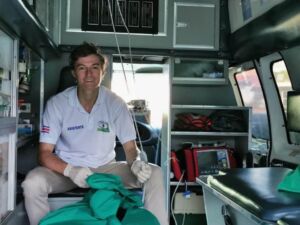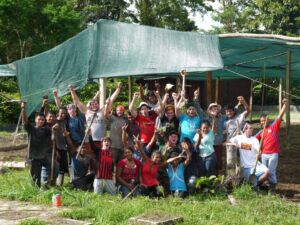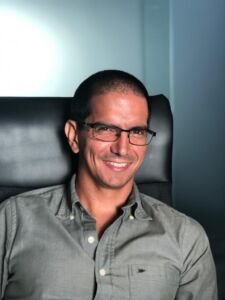One of the issues with many psychological disorder diagnoses is that they can give the impression of a hard division between mental illness and its absence. However, the reality of how people experience mental health issues is not black or white; it’s mostly some kind of oscillation between shades of gray. Gap year experiences have the potential to fill these shades of gray in mental health.

The field of psychology has historically struggled to adequately address the continuum of mental health issues and has been criticized for focusing on psychological illness much more so than on psychological health, let alone address all the gradients in between.
This criticism of psychology is not new. The Humanistic Psychology movement made this argument several decades ago, and more recently, Positive Psychology has as well. On this note, the founder of Positive Psychology: Martin Seligman, has proposed that focusing on mental fitness, and not so much on mental illness, may address some of these gaps that psychology has been criticized for. To explain this point Seligman and his collaborators, Rosen Kellerman and Robichaux (2020), use the analogy of going to the gym and getting a personal trainer to improve heart’s health, instead of going to the cardiologist to get a workout plan. The cardiologist is qualified to deal with cardiac illness, but might not be the most qualified to put together an exercise routine. Likewise, a psychotherapist may be sought for mental illness, but might not make sense to be sought to improve general resilience and coping skills. These skills might be better gained from guided experiential learning experiences, such as those lived in a gap year, rather than in a therapy session.
This is where a gap year can fill in these gaps in mental health. Even though many young adults do suffer from mental illness (more than any other age period, actually) and need treatment for it, all young adults need to work on their mental fitness, but especially one group in particular. There is a large percentage of young adults that are perceived as “doing ok” and generally “functional”, but would describe their life as stressful, plagued with mental fatigue and emotional burnout. These individuals may not have a diagnosable psychological disorder, but are probably experiencing what Adam Grant calls “languishing” (Grant, 2021). Languishing is characterized by a sense of emptiness, stagnation, numbness and difficulty accessing feelings of joy and satisfaction. Languishing is not a mental illness but adds between two and six times the risk of developing major depressive disorder (Keyes, 2002).

A gap year provides excellent opportunities for mental fitness. A gap year participant expressed how he grew in resilience in the following way: “having to deal with uncomfortable situations really gave me a new perspective on how I need to focus on my priorities and how much the short-term discomforts are worth it in the long term” (Youngberg, Recio, & Tracy, 2020). Another participant demonstrated new skills in flexibility, adaptability and cognitive complexity in the following way: “spending time with people from a different culture, living with them, becoming their friend, has made me realize that my way is not always the way” (Recio, 2018).
The reflections shown above are clear examples of mental fitness. Gap years can contribute toward mental fitness because they challenge participants’ adaptability through engaging with new people, activities and perspectives. They also invite reflection and the development of new and more robust personal narratives. A gap year can support the development of skills like resilience and creative problem-solving (Youngberg, Recio, & Tracy, 2020), cognitive complexity and divergent thinking (Recio, 2018), and increase maturity, confidence and to develop purpose in life (Hoe, 2015). These seem exactly the outcomes that young adults need to go from languishing to flourishing.

There are gap year programs that specialize in supporting participants with diagnosed psychological disorders, while there are others that specialize in this “languishing” population. The former might be recognized as therapeutic gap year programs, while the latter as wellness gap year programs. That said, gap year programs without this specific focus can support mental fitness for their participants if they employ evidence-based coaching methodologies. Doing so may help their participants be better positioned to not only avoid mental illness in the future, but also flourish on their way to adulthood.
Some aspects that may help ensure that gap year programs are supporting mental health and mental fitness are:
- Assessment: making sure programs possess adequate tools and experts to assess the level of need of each individual in the mental health spectrum.
- Gap year consultants: using gap year consultants to help determine whether a participant will be better served at a wellness or therapeutic gap program instead of one without these levels of support.
- Framework: the field of mental health and wellbeing is very diverse and offers numerous research-based approaches. Finding the one(s) that best fit the ethos and style of the gap year program, and integrating it into the philosophy and methodology of the program, may make a marked difference in supporting mental fitness intentionally.
- Training: staff at gap year programs don’t have to be clinicians to support the general population toward flourishing. Life coaching training and other specific training related to promoting wellbeing in young adults may make huge differences in the short and long term outcomes of gap year participants.
In a time where mental health issues are on the rise and guided opportunities to build mental fitness are scarce, gap years emerge as the rites of passage for our time, to go from languishing to flourishing, from mental suffering to mental fitness, and to prepare for the challenges that adulthood inherently brings.
References:
Grant, A. (2021). There’s a name for the blah you’re feeling: It’s called languishing. The New York Times, 19(4).
Hoe, N (2015). Gap year association national alumni survey. Gap Year Association. https://www.gapyearassociation.org/wp-content/uploads/2021/05/2015-NAS-Report.pdf
Keyes, C. L. (2002). The mental health continuum: From languishing to flourishing in life. Journal of health and social behavior, 207-222.
Recio, D. (2018). Coming of age in foreign lands: Overcoming the double hurdle to adulthood using the developmental benefits of cross-cultural immersions. Journal of Therapeutic Schools and Programs, 10(1), 169-185. doi: 10.19157/JTSP.issue.10.01.08
Rosen Kellerman, G., Robichaux, A., & Seligman, M. (2020). How to make your employee mental health strategy better? Start focusing on growth. Better Up. https://www.betterup.com/blog/how-to-make-your-employee-mental-health-strategy-better-start-focusing-on-growth
Youngberg, K., Recio, D. & Tracy, H. (2020). Supportive Immersion: The Use of Transformative
Cross-Cultural Experiential Learning to Address Social Trends in the 21st Century. Journal of Therapeutic Schools and Programs, 17(1), 117-138. doi: 10.19157/JTSP.issue.12.01.07
ABOUT THE AUTHOR
 Danny Recio, Ph.D., LPC is the co-founder of the Supportive Immersion Institute, an organization that utilizes international gap year experiences for psychological healing and transformational experiential learning. Danny is the director of two of Supportive Immersion’s programs in Costa Rica: The Bridge, a therapeutic gap community for young adult males, and Si!Gap, a co-ed wellness gap experience.
Danny Recio, Ph.D., LPC is the co-founder of the Supportive Immersion Institute, an organization that utilizes international gap year experiences for psychological healing and transformational experiential learning. Danny is the director of two of Supportive Immersion’s programs in Costa Rica: The Bridge, a therapeutic gap community for young adult males, and Si!Gap, a co-ed wellness gap experience.
Categories
- Advising (6)
- Alumni (2)
- Career (4)
- College & University (13)
- Communication (17)
- DEIA (4)
- Fair Trade Learning (3)
- Finances (11)
- Gap Year Benefits (66)
- Growth & Development (5)
- Leadership (5)
- Learning & Reflection (53)
- Mental Health (3)
- Planning (57)
- Professional Development (4)
- Research (3)
- Risk Management (3)
- Safety (5)
- Service-Learning (10)
- Standards & Accreditation (1)
- Sustainability (6)
- Voices Project (20)
